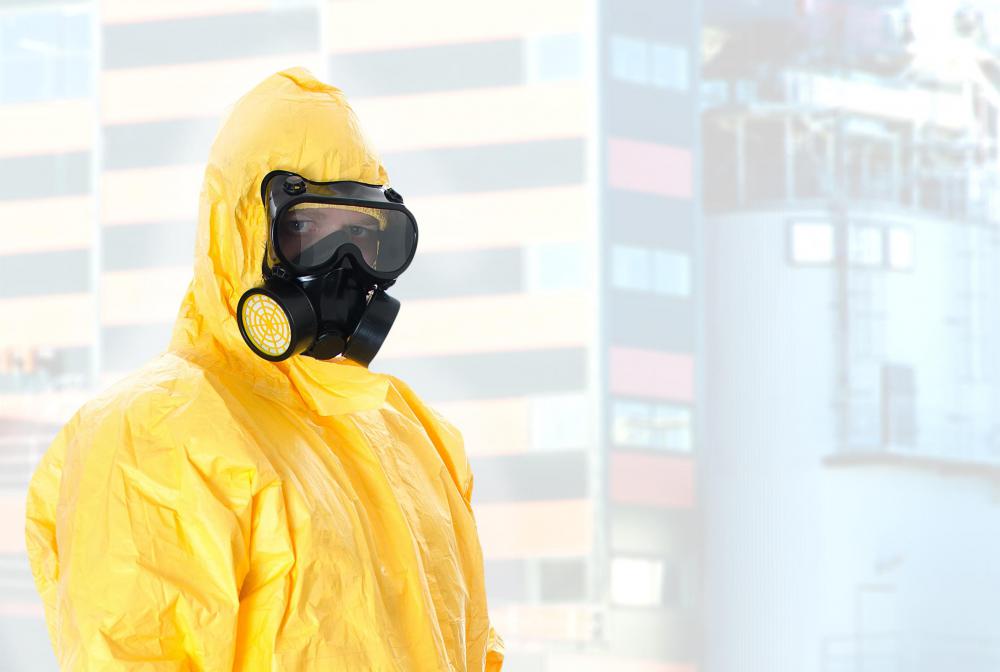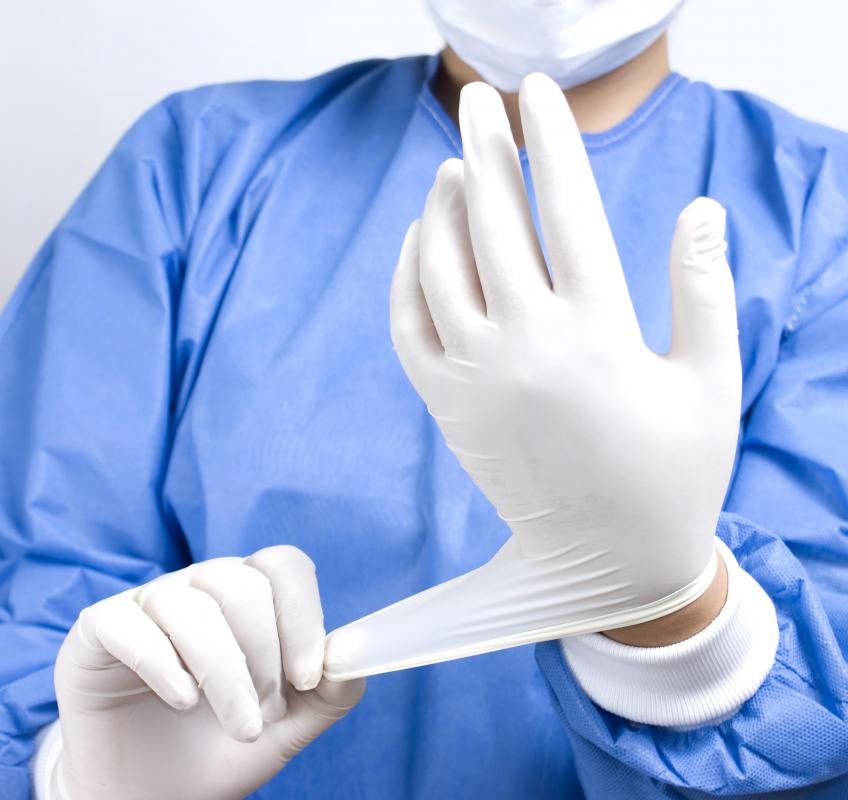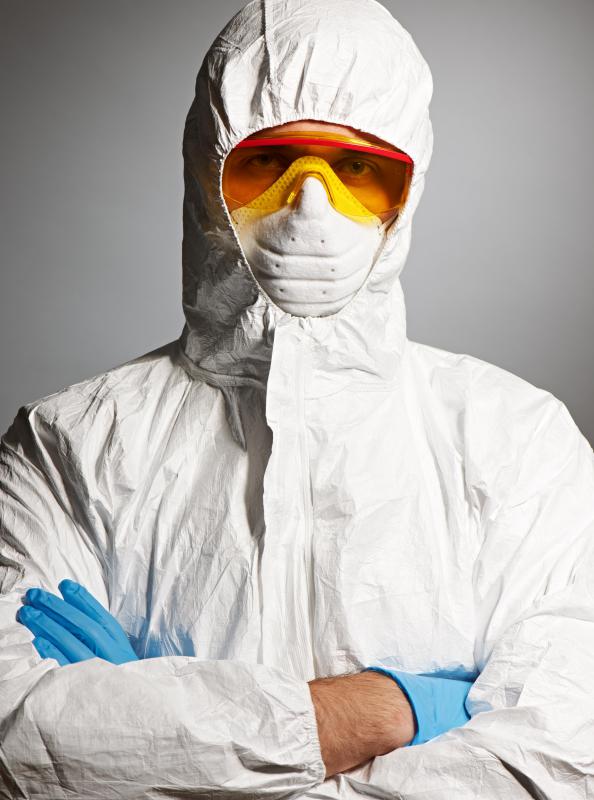At InfoBloom, we're committed to delivering accurate, trustworthy information. Our expert-authored content is rigorously fact-checked and sourced from credible authorities. Discover how we uphold the highest standards in providing you with reliable knowledge.
What Is a Biological Hazard?
A biological hazard, also known as a biohazard, is an organism or a by-product from an organism that is harmful or potentially harmful to other living things, primarily human beings. Common types of biological hazards include bacteria, viruses, medical waste and toxins that were produced by organisms. The "biohazard” symbol is a familiar sight in hospitals, and any object that carries it should be treated with extreme caution. Biological hazards vary in their degree of severity and the precautions employed when handling, storing or disposing of them are determined accordingly.
Chemical and biological hazards differ in that the latter may have the potential to pass from person to person. This makes it particularly important that all precautions are strictly observed by those working with, or coming into contact with, biologically hazardous materials. In a worst-case scenario, inadequate precautions, or a failure to observe them, could lead to a major outbreak of a fatal disease. This is extremely unlikely, however, as establishments that carry out research into disease causing infectious agents are carefully designed to prevent accidental release and have strict biosafety rules.
Working with Biological Hazards

Hospital staff routinely come into contact with potentially hazardous materials, such as used syringes and discarded dressings. These are normally put into special, clearly marked bags and containers for incineration. The use of disposable gloves, combined with basic hygiene practices, such as frequent washing of hands and disinfection of surfaces, helps prevent these materials from causing disease.

The need to develop new treatments and vaccines means that it is sometimes necessary for people to work with potentially lethal biological agents. Bacteria can acquire resistance to antibiotics, so that new compounds, or alternative methods of treatment, have to be found. Some viruses mutate rapidly, rendering vaccines ineffective and requiring the development and testing of new ones. In other cases, there has never been a vaccine. Research into dangerous microorganisms, or pathogens, is carried out at highly specialized establishments, which employ a range of precautions, procedures and equipment to prevent infection and escape.
Equipment and Precautions

Microorganisms could potentially escape from laboratories either through infection of staff or directly, through materials that have come from the laboratory without being decontaminated. This could include waste material, clothing worn by staff or aerosols — tiny, suspended droplets or particles — that could leave the building via doors, windows or ventilation systems. A number of items of equipment are used when handling biohazards.

A biological safety cabinet (BSC) is employed when working with pathogens where there is a risk of splashes or aerosol formation. It is a self-contained unit with its own air supply in which the sample is placed. Laboratory staff work with the material via protective gloves that are built into the cabinet.
High efficiency particulate air filters (HEPA) may also be employed to filter all air leaving the working area. Another common precaution is to have a negative air pressure within the danger area, so that when doors are opened air will flow in rather than out. In extreme cases, staff may have to wear sealed protective suits with their own air supply.

Precautions include taking special care with sharp instruments, restricting access to areas handling dangerous pathogens to suitably qualified people and ensuring that nothing leaves the laboratory without first having been decontaminated. This can include people, who may have to shower before leaving. Generally, staff will be required to change into appropriate laboratory wear before entering the danger area and change back again when leaving it. In addition to the standard procedures, there are further requirements that relate to the nature of the hazardous material.
Biological Hazard Levels

In the USA, the Center for Disease Control and Prevention (CDC) has determined four levels of biological hazard. A similar system exists in Europe and in many other parts of the world. The categories depend upon factors such as the infectiousness of the agent, the seriousness of the disease it may cause and whether or not there are effective treatments and vaccines. If any of these factors are unknown, typically the highest level of hazard will be assigned until more information is available.

Biological hazard level 1 (BSL-1) is assigned to agents that do not generally cause disease in healthy humans. An example would be bacillus subtilis, a common soil bacterium that is much studied by geneticists and which can occasionally cause illness in people with severely weakened immune systems. For these agents, no special containment is required and normal microbiology laboratory procedures, such as wearing gloves and a face-mask, are adequate. The agents are considered suitable for undergraduates and staff undergoing training to work with.
BSL-2 is for agents that can cause disease, possibly serious, in healthy humans, but which already exist in the population outside and are not transmissible by inhalation. These agents can only cause infection through direct contact with infected material via cuts and abrasions or through ingestion. Examples are human immune deficiency virus (HIV), the hepatitis B virus and salmonella. Biohazard symbols must be clearly displayed and BSCs or similar devices are used for any work that might cause splashes or produce aerosols. An autoclave must be present, to allow sterilization of instruments. Access to BSL-2 areas is restricted to trained staff.
BSL-3 applies to pathogens that cause serious and life-threatening diseases and which can become airborne, for example, the bacterium that causes tuberculosis. These microorganisms can infect without direct contact with contaminated material, so they require particularly stringent precautions. Access to the working area is very restricted and BSCs are used for all work with materials that may contain the pathogen.
BSL-4 is reserved for pathogens that cause diseases with high fatality rates and for which there are no effective treatments or vaccines, for example, Marburg virus. It may also be used for agents whose characteristics are unknown or not fully understood, such as a new strain of influenza or a disease that has not previously been seen in humans. Over and above the procedures for BSL-3, all staff must work in full-body pressure suits with their own air supply and must shower before leaving. All materials leaving the laboratory must be decontaminated.
AS FEATURED ON:
AS FEATURED ON:

















Discussion Comments
How many chemical hazards are there?
@ Fiorite- At first I honestly didn't believe that those types of viruses were present in the United States, but after visiting the CDC website I have changed my mind. The most up to date CDC data shows that there have been almost 550 total confirmed cases of Hantavirus in 32 different states. New Mexico, Colorado, and Arizona have had the most confirmed cases in that order. After reading what these types of biohazards do to the body, it makes me really dislike rodents.
One thing I must say is the health community does a very god job controlling these diseases, because a level four biohazard is very dangerous to public safety. Hazard identification has been excellent, and the number of deaths from this and other high-level biohazards has been fairly limited.
I live in the Southwestern Desert and there are a few level four biohazards, which kill a handful of people every year. People often think of outbreaks of Hantavirus and bubonic plague as a thing of movies, medieval times, and isolated villages in developing countries, but these outbreaks can occur in cities across the nation, and the outcomes are often fatal.
About five or six people are infected by the Hantavirus in Arizona every year, and it is considered a workplace hazard for some professions in the state. The virus is spread by rodents, mostly deer mice, and is transmissible through the air. Contact with dead rodents, their nests, and their droppings can cause infection. The incubation period can be up to six weeks, but once symptoms start to show the virus can be fatal. About 40% of those infected die within one to two weeks.
Post your comments